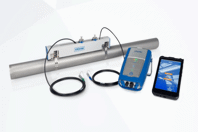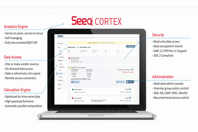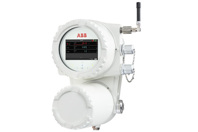Pumps & Controls
PRODUCTS
-
Learn about KROHNE's ultrasonic clamp-on flowmeter for temporary flow measurement of liquids.
-
When using Seeq, teams can easily create automated SPC control charts which can empower data driven decisions.
-
Workbench, Organizer, and Data Lab are powered by Cortex, which enables Seeq calculations at scale, data connectivity, and administration features.
-
ABB’s Sensi+ analyzer offers a reliable new solution which simplifies and reduces the cost of pipeline operation and maintenance. It enables safer, easier, and more efficient pipeline monitoring and operations through a single device that can analyze up to three contaminants (H2S, H2O, CO2) in any natural gas stream accurately and in real time. Its fast response also enables quick reaction to process upsets, thus helping to reduce waste and methane emissions.
-
GWT electrocoagulation (EC) technology has become a valuable solution in the treatment of water and wastewater due to its ability to remove contaminants that are generally more difficult to remove by filtration or chemical treatment systems, such as emulsified oil, silica, total petroleum hydrocarbons, refractory organics, suspended solids, and heavy metals.
WHITE PAPERS AND CASE STUDIES
-
Advantages Of Thermal Dispersion Switches For Pump Protection
Thermal dispersion switches use similar principles as thermal mass flow meters. Fluid carries heat away from the probe tip reducing the temperature difference between a heated resistance temperature detector (RTD) and a reference RTD.
-
Decrease Operating Costs By Replacing ESP With Hydraulic Jet Pump
A customer replaced 6 ESPs (Electric Submersible Pump) within a 4-year period. Seven months after installing a JJ Tech Jet Pump, no workover rig has been needed and the well remains as productive as it was on ESP.
-
White Paper: The Next Generation Of Progressive Cavity Multiphase Pumps Use A Novel Design Concept For Superior Performance And Wet Gas Compression In the last two years, extensive testing and development has led to a new concept that has successfully demonstrated that the operating envelope of the progressive cavity multiphase pump can be expanded to handle not only higher gas volume fractions, but also much larger volumes of gas, and at the same time increased the service life of these multiphase pumps.
-
Case Study: Explosion-Proof Electric Anchor Pump And Electric Control Panel Improve Landfill Gas Capture Landfill gas collection and control, leachate recirculation and liquid application are critical to bioreactor landfills designed to maximize environmental recovery. In 2000, the Salem County Utilities Authority Landfill Facility (SCUA) in Alloway, N.J., began recirculating leachate within its landfill mass
-
Case Study: Anchor Pump Successfully Recovers Creosote Oil From 250 Feet Well BLACKHAWK ENVIRONMENTAL COMPANY’S Anchor Pump was used to successfully recover creosote oil from a 100-year-old wood preserving operation that produced wood products
-
Case Study: Blackhawk's Anchor Pump® For Tough DNAPL Recovery BLACKHAWK ENVIRONMENTAL COMPANY’S Anchor Pump, positive displacement piston pump, effectively cleans up and recovers Dense Non-Aqueous Phase Liquids (DNAPL). Typically DNAPL is found in 20’ to 120’ deep wells with DNAPL often residing in the bottom few feet or inches of the well
-
Case Study: Blackhawk Explosion-Proof Anchor Pump Handles Explosive Situation With Aplomb A top-tier gas and power marketer in the U.S. and a Fortune 500 company takes its role as a corporate citizen and innovator in energy solutions seriously, working to protect the environment and to support the communities where the energy company works and lives
-
Case Study: Efficient Windmill Powered Anchor Pump Blackhawk Environmental Company's Windmill Anchor Pump is designed specially for landfill applications. BLACKHAWK Windmill Anchor Pumps, using wind power source, feature 100-year-old windmill head design technology combined with lightweight, high–tech materials which make installation and on-site maintenance easy. Blackhawk has windmill pumps successfully operating in many U.S. landfills pumping from 500 - 1500 gpd
-
Blue Bunny Mastered RFID And Process Controls Podcast Podcast: Wells' Dairy Case Study
NEWS
-
The AccessESP Rigless System Successfully Enables ESP Pump Swap1/4/2017
AccessESP, a leading provider of rigless electric submersible pump (ESP) conveyance solutions for the worldwide oil industry, has showcased its rigless ESP conveyance system in the industry’s first pump swap for an operator on the North Slope of Alaska.
-
Impact Of The Trump Administration On The U.S. Pump Markets12/28/2016
The market for industrial pumps in the U.S. is likely to be greater over the next few years with Trump as president than it would have been had Clinton been elected.
-
Sulzer’s Pump Technology, Turbine Solutions And High Voltage Coils On Show At Turbomachinery & Pump Symposia 20168/23/2016
Houston, Texas will again host this year’s Turbomachinery and Pump Symposia (TPS), where Sulzer will be on hand to demonstrate how improved performance and reliability can be delivered for rotating equipment.
-
Sulzer Bringing Latest Pump Designs And Coating Technology To Turbomachinery & Pump Symposia 20159/9/2015
This year’s Turbomachinery and Pump Symposia, held in Houston, Texas, will see Sulzer showing the benefits of investing in the latest technology to deliver long term performance and reliability. By Jennifer Cardillo, Marketing and Communications Manager, Americas, Rotating Equipment Services
-
Flowrox Launches New Product For Pump And Dampener Maintenance2/27/2015
Flowrox, a global leader in heavy-duty industrial valve manufacturing and services, is announcing the launch of the Flowrox Expulse™ product, designed to assist during pump and dampener maintenance by reducing noise and vibration associated with traditional methods—which can lead to pipe damage that can cause breakage and a loss of revenue.
PUMPS & CONTROLS ABOUT DOCUMENT
Pumps & controls
Upstream and downstream segments of the oil and gas industry use pumps and control systems for production. Pumping facilities are usually needed in the oil and gas industry for pumping crude oil, refinery waste waters, drilling mud, catalyst slurries, and corrosion inhibitor among others. Control instruments such as control valves are also important in checking fluid flow. The array of application of these pumps and controls stresses the difference they make in the oil and gas industry.
Pump manufacturers have made some forward advancement both in the type of pumps they make and their presentation. For instance, there has been a growing trend of manufacturers sending a group of experts who will help with designing of a tailor made pump. This ensures that each application has a pump that suits its functions and complexities. The overall outcome of such improvements in the industry includes improvement in energy consumption levels, safety and maintenance costs. The other advantages of this new tendency are higher profits and production.
Other than the obvious qualities, there are certain attributes that one should look out for in a pump. Erosion tolerance is an important aspect that needs to be considered particularly in pumps that carry solids such as sand. The pumps should also be able to deliver stable fluid flow. This stability should always be there across wide pressure intervals. Pumps intended for oil and water mixture should be able to safely transport products with low shear. This helps in avoiding emulsification.
Control technologies have been advanced to ensure that monitoring can be done remotely to avoid certain obvious exposure hazards. There are control instruments available for downstream, upstream and midstream markets. One needs to ensure that the manufacturer who provides their pump and control facilities will be able to check equipment issues and monitor the equipment.




